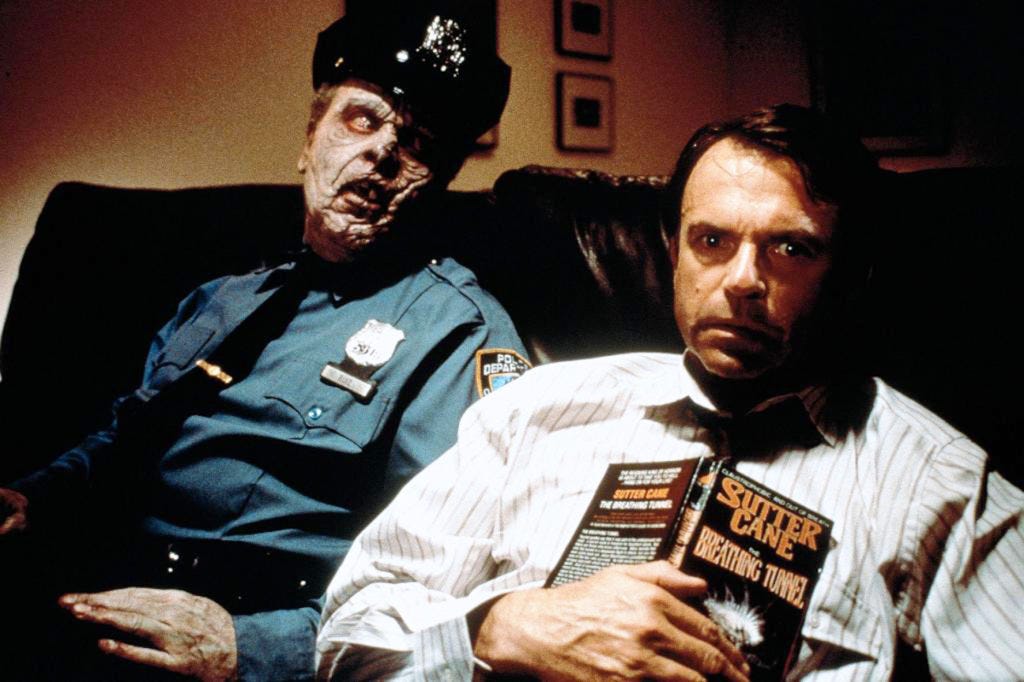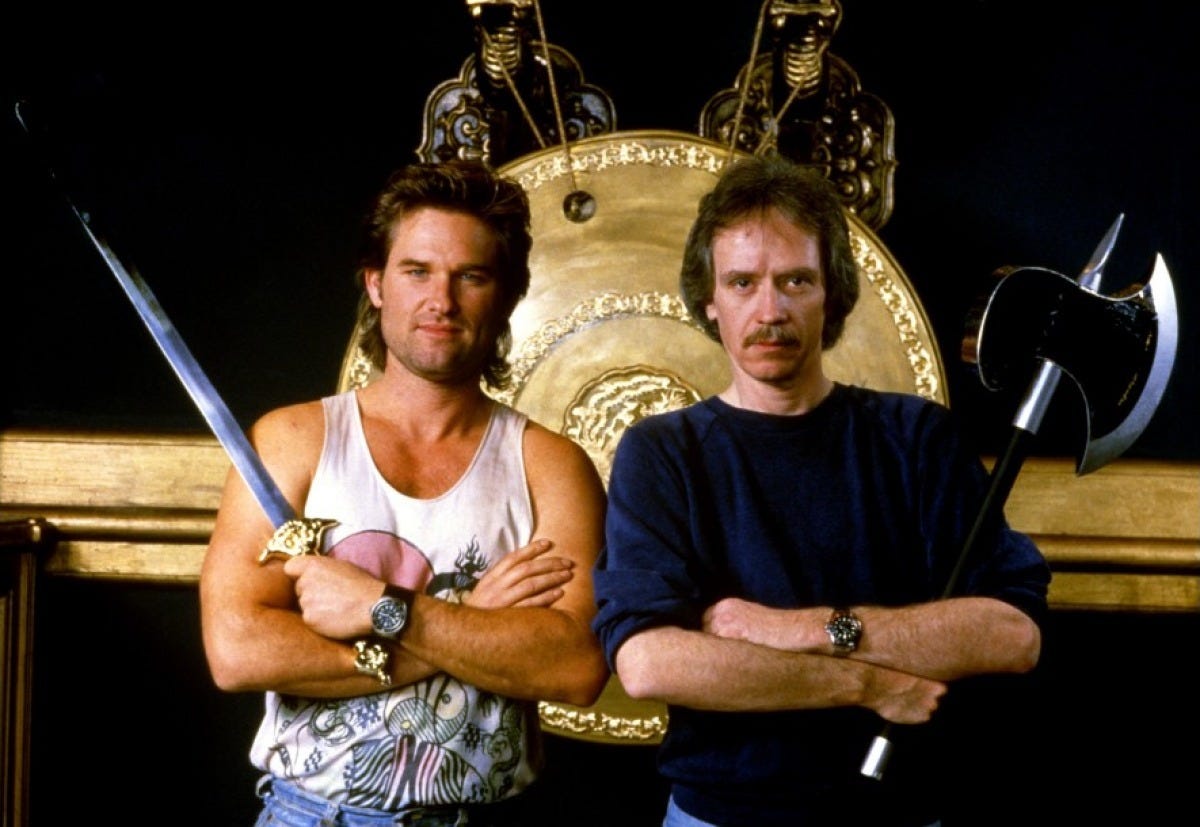John Carpenter, Genre Genius
The director of 'The Thing' at 74.
On January 16, the great film director John Carpenter turned 74 years old. His last movie, a horror picture called The Ward, came out eleven years ago. It’s not outside the realm of possibility that Carpenter may one day make another movie; every so often he’ll give an interview in which he says he’d like to direct again and that he has some story ideas, though at other times he says he’s perfectly happy in retirement, playing video games and watching basketball. A frequent composer of his own film scores, for the last six years his creative focus has been on releasing albums and touring with his son. But even if The Ward is Carpenter’s last word on making movies, his legacy as one of the great American genre masters is secure.
It’s important to note that when I call John Carpenter a genre master, I don’t mean a specific genre. Carpenter himself may use the Twitter handle @TheHorrorMaster (more than likely because of a Showtime anthology series he was involved in, called Masters of Horror), but he has made horror films, science fiction films, fantasy films, thrillers—early in his career, he even made a very good TV biopic about Elvis Presley. And there’s a decent chance that if you were to pick one of his films out of a hat, you’ll find that Carpenter has mixed and matched his genres, even occasionally indulging in his talent for comedy. Carpenter is genuinely funny, and it’s a bit of a shame that he hasn’t followed that path more often. His very first movie, Dark Star, is in fact a science-fiction comedy. Initially a student film made during his time at USC, Carpenter eventually bulked it up to feature length and it was released in 1974. Co-written by Carpenter and future Alien screenwriter Dan O’Bannon (who also co-stars in the film), Dark Star depicts with completely deadpan dark humor one spaceship crew’s mini-apocalypse.

Two years later, Carpenter, while still staying within the world of genre cinema, would pivot to a completely different kind of movie. The crime film Assault on Precinct 13, which Carpenter also wrote, is essentially his riff on one of his favorite films by one of his favorite directors, Howard Hawks’s Rio Bravo. (It’s surprising that Carpenter has never made a straightforward Western, though he was once attached to Tombstone.) In Carpenter’s version of the story, a police precinct in South Central is about to shut down in the middle of a war between the cops and a violent street gang called Street Thunder. The gang carries out an ambush on the barely staffed precinct, leaving Lt. Bishop (Austin Stoker) and Napoleon Wilson (Darwin Joston), one of the few prisoners still held in the precinct’s jail, to lead them all through a war zone to safety.
Assault on Precinct 13 is one of Carpenter’s best films: lean, propulsive, expertly framed and staged. Watching it now, one gets the sense that the director was born to do this, so precise are his instincts for how to stage and shoot action. The movie is also rather notorious, because of one moment of violence in a rather violent movie, a choice Carpenter made that suggested to anyone who saw Assault on Precinct 13 that this was a director who perhaps could not be trusted to deliver, even in a relentlessly entertaining action picture, easy, ignorable comfort. About 30 minutes into this 90 minute film, one of the gang leaders (Frank Doubleday), with dead-eyed composure and for no good reason, shoots a little girl (holding an ice cream cone, no less) in the chest. This moment has had such an impact on everyone who sees it that I have regularly, over the years, seen it described as something that happens within the first few minutes, but we’re a full third of the way into the film when it occurs. Yet it defines what our heroes are up against with such starkness that it can overwhelm the audience.
The film took some time to catch on. Early reviews in America were unsympathetic, but audiences at European festivals later on embraced it. This sort of delayed affirmation would become an unfortunately common aspect of Carpenter’s career. He would, of course, enjoy his single greatest success, both critically and financially, in 1978 with the release of Halloween (which he co-wrote with his producer and frequent writing partner Debra Hill), a horror film that would define the slasher subgenre and launch a franchise with which Carpenter has had almost no involvement, other than cashing a number of well-deserved paychecks. And listen, Halloween is terrific, perhaps the best evidence up to that point of Carpenter’s genius for framing, and his exquisite eye for detail—Michael Myers’s curious head tilt while regarding the young man he’s just pinned to a wall with a knife is an indelible horror image, and the kind of thing most directors working in the genre would never even think of—but as far as I’m concerned, his true genius had not yet revealed itself.
After Halloween, Carpenter made a couple of hits that received mixed reviews: The Fog (1980), a delightfully old-fashioned and atmospheric ghost story, and, more famously, Escape from New York (1981). Woven through these theatrical features were the aforementioned Elvis (1979), which began his fruitful series of collaborations with Kurt Russell, and a made-for-TV thriller called Someone’s Watching Me (1978), starring Lauren Hutton. But while Escape from New York—Carpenter’s second project with Russell—is, like Halloween, a landmark, things didn’t get really interesting until 1982. That’s when Carpenter made what is unquestionably his masterpiece, The Thing.

Which, ironically, is where the trouble started. The Thing is often referred to as a remake of The Thing from Another World (officially credited to director Christian Nyby, though there is some debate about whether it was actually directed by the film’s producer, and hero to Carpenter, Howard Hawks), though in truth it’s really a much more faithful adaptation of the original source novella, John W. Campbell’s “Who Goes There?” As in Campbell’s story, Carpenter’s film revolves around an American scientific research station in Antarctica. The short version of what transpires is that an alien, shape-shifting lifeform secretly invades the station, and one by one begins taking over the forms of each scientist, or if discovered killing them in a gory frenzy, sending shockwaves of paranoia through the rest of the base.
Built around a perfect cast of character actors, led by Kurt Russell as the cynical, smart, yet quietly terrified MacReady, with a script by Bill Lancaster (who also wrote The Bad News Bears), with much input from Carpenter, The Thing is an astonishingly effective piece of SF horror. The essential drama, and terror, of men in an extreme location pushed to the limits of survival by a creature they cannot understand, is heightened by Rob Bottin’s jaw-dropping and surreal creature and make-up effects. Many of the images Carpenter, Bottin, and cinematographer Dean Cundey devised—such as a severed human head sprouting spider legs and skittering across the floor, or a man’s body being dragged by the skin of his face—are unforgettable, and, indeed, grotesque. This last bit was a problem for many critics. Roger Ebert called it a “barf-bag movie,” while David Denby called the gore effects an “obscenity.” Both critics, as well as many others, missed entirely the unique brand of horror Carpenter and his collaborators were working with; that is body horror, in which what is done to the human body—either by outside forces or the body itself, which The Thing kind of deals with simultaneously—provides the terror, the theme, and the visual style of the film. Watching the film now, or even then, the power of The Thing seems plain, but the damage was done. Hardly anyone saw it in 1982, and suddenly Carpenter’s career was struggling.
It’s easy to look back on the films Carpenter made subsequently and think that, given the esteem with which so many of them are now held, it was just one hit after another. Yet many, even those that seem like financial slam dunks, like his excellent adaptation of Stephen King’s Christine (1983) and the crowd-pleasing work of SF populism Starman (1984), made very little, if any, money, and were met by critics, on average, with a shrug. But as Carpenter’s budgets shrank, his desire to make whatever he wanted to make within those confines seemed to increase.
The Thing wound up being the first part of what Carpenter came to refer to his Apocalypse Trilogy. Connected only by their, well, apocalyptic imagery, collectively the films mark Carpenter’s greatest achievement on film. The second part, Prince of Darkness from 1987, is a magnificently weird bit of cosmic horror, which locates a group of quantum physicists in a Los Angeles church, trying to solve the mystery of an ancient cylinder of green liquid. Expertly combining no-nonsense pulp with smart, intriguing, and frightening philosophical implications (the idea of the “anti-God” is simply brilliant), Prince of Darkness is deceptive in what it seems to be trying to achieve versus what it actually achieves, until, perhaps, those final apocalyptic images.

The third part of the trilogy, In the Mouth of Madness (1994), is, if anything, even pulpier than Prince of Darkness, and I don’t claim that it has the same level of intelligence hidden within that earlier movie. But as a kind of deconstruction of the horror genre itself, by way of a fictional avatar for Stephen King and, more explicitly, H.P. Lovecraft (both found in the same character, horror writer Sutter Cane), In the Mouth of Madness has its own kind of eerie power. Once again, Carpenter lays his strange visuals on thick, with the result being that like the other parts of the Apocalypse Trilogy, it looks and feels nothing like any other horror film from the 1980s or 90s, other than those also made by John Carpenter.
But as I alluded to earlier in this piece, horror is just one of the genres at which Carpenter excels. Before getting to Prince of Darkness or In the Mouth of Madness, he made another film that failed at the box office but is now beloved and considered a classic. Big Trouble in Little China is a marvelous fantasy-comedy, about an arrogant truck driver hero named Jack Burton (Russell) who, through his friendship with Wang Chi (Dennis Dun), falls rather casually into a somewhat unhinged adventure revolving around ancient Chinese gods and demons and rituals. Two of the funniest ideas fueling the story are that almost none of the characters are surprised by anything that happens to him, or the wild sights they see; and that the film’s ostensible hero, Jack Burton, is in fact a complete dope who is saved again and again by the guy who’s supposed to be his sidekick.
Alas, again, a great Carpenter film disappeared without a trace. Until, of course, later. Eventually, to some degree or another, these movies found their audience, and Carpenter’s reputation as a truly gifted filmmaker seems to rise higher year after year. Movies that at one point no one saw now seem to have been seen by everybody. As recently as 2019, Carpenter received a special award at the Cannes Film Festival. When asked in 2015 how it felt to experience this change in fortune that he and his films have enjoyed over the last couple decades, John Carpenter told Filmmaker Magazine, “It’s great. It’s better than people calling me a piece of shit all the time.”



